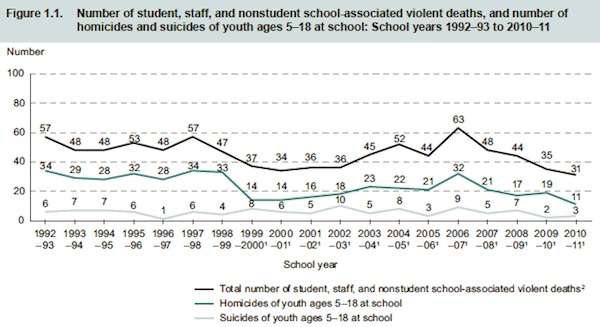Are School Homicides 'Becoming the Norm'?
Don't assume schools are getting more violent.

In the aftermath of yesterday's shooting at an Oregon high school, the president worried that such slayings are "becoming the norm." I've written skeptically in the past about whether the number of mass shootings in America is actually increasing, as the word becoming implies—see my posts here, here, and here—but there's always a haze of uncertainty around those numbers, thanks to the varying definitions of "mass shooting" that different people use.
But maybe that isn't the best thing to be measuring in the first place. The Oregon incident isn't a "mass" shooting at all—the gunman killed two people, and one of those was himself—but it obviously speaks to the same sorts of fear and grief. If your son was just shot, after all, it's hardly a comfort that his classmates survived. A map darting around the Internet this week claims to show all the school shootings since Sandy Hook. Note the modifier: school, not mass.
So how frequently are people killed at school? The Bureau of Justice Statistics (BJS) keeps a running count of such homicides, with "at school" defined to include deaths not just on school property but "while the victim was on the way to or from regular sessions at school or while the victim was attending or traveling to or from an official school-sponsored event." You might quibble about whether those off-campus killings belong in this category, but still, it's a straightforward definition that doesn't get bogged down in how many people die in one attack or, for that matter, what weapon was used to murder them.
As it happens, the bureau published a new report on school violence this month. Here is the relevant chart:

With the caveat that with numbers this low it's easy to be misled by random noise, I'll point out that the figure has fallen. Note also that these are raw totals, not deaths per population. A chart of school homicide rates would show an even steeper decline.*
But has that decline come to an end? As you can see, the bureau's figures only go through the 2010–11 school year, thus excluding the Sandy Hook massacre and everything since. Twenty children and six adults were murdered at Sandy Hook, making the event bloody enough to cause a spike in 2012–13 all by itself. We don't have enough data to say for certain whether that year was an outlier like 2006–07 or the start of a new trend, but the authors do offer some tentative numbers for the period since the massacre. According to "preliminary counts from media reports," they write, the U.S. saw "17 school-associated violent deaths between December 15, 2012, and November 14, 2013"—11 homicides and six suicides, with six of the dead being of student age.
Those numbers might sound surprisingly low if you've seen the aforementioned map of school shootings since Sandy Hook, which draws on data from the gun-control group Everytown. In part that's because its count stops this month instead of last November, but it's also because it includes colleges. (Of the 74 incidents listed by Everytown, 35 occured on or near a college campus.**) The map also includes nonfatal shootings, including accidental discharges and at least four events in which no one was injured at all. And some of its items qualify as "school shootings" only under a rather broad understanding of the phrase. While this killing, for example, did take place in an elementary school parking lot, it happened at night, long after the students and teachers had gone home. The victim was 19.
This much is clear: If you're wondering where kids are likely to die, the answer plainly isn't a classroom. (Quoting the BJS report one more time: "During the 2010–11 school year, 11 of the 1,336 homicides among school-age youth ages 5–18 occurred at school.") And in the period for which we have clear data, the school homicide rate moved in the same direction as the overall homicide rate: downward. To bring it still lower, the first question to ask is what happened to get us that far.
(* The researchers are still interviewing officials about some of these incidents, so there's a chance that some will be reclassified in future reports.)
(** The BJS report includes a separate discussion of college-level crime. "Fifteen murders occurred on college campuses in 2011, the same number as in 2010," it notes. The authors don't go into detail about homicides in earlier years, but they do say the "number of on-campus crimes reported in 2011 was lower than in 2001 for every category, except for forcible sex offenses.")


Show Comments (53)